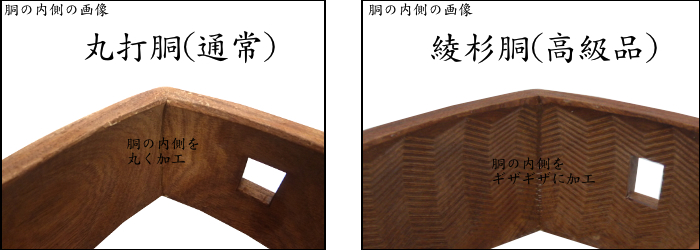I found a chuko shamisen but I can’t seem to find any information by what it means with the words Maruuchi-Do to describe the dou. Any ideas?
Under most circumstances, that means a shamisen with a smooth interior.
Compared to shamisen with decorative carvings on the inside or ayasugibori (herringbone patterned carvings meant to improve sound quality), they are usually cheaper and occasionally older.
A good visual comparison can be found here:
Whether or not ayasugi actually impacts sound quality is up in the air; but it’s usually a marker of a high-quality instrument due to the time required to carve the patterns.
I don’t mean to necro an older thread but I kinda freaked out over the weekend and saw that my shamisen had no pattern engraved on the inside - totally smooth like in the left pic above. I’m totally new to shamisen and thought maybe I got jipped or something. Christopher you are a wellspring of shamisen knowledge. Thank you.
So I’m pretty sure I have a Nagauta shamisen. Are these patterns typical for a particular style or just newer and/or more higher end instruments?
As far as I know, ayasugibori can be found in all types of shamisen presently. At the very least, I have seen all types of shamisen sporting it.
It is an indicator of cost an craftsmanship, although not the sole one.
I am not very well versed on its history, so I would be hard pressed to give a better answer than that.
Reigen once said that he preferred maru-uchi shamisen, tone-wise. I’m skeptical that one could notice a significant difference between the two, but considering I’m putting a rod in the nakago and sao to improve the tone, (which in reality probably won’t make any difference) that might be slightly hypocritical of me to say. 
I’ve identified ayasubi-bori shamisen before by sound alone, but I gotta say it’s hard to tell whether that speaks to the impact of the ayasugi themselves or the craftsmanship and materials as a whole.
Like most things in the shamisen game, I really feel it’s a small numbers game that all contribute to a specific sound.
Reigen once said that he preferred maru-uchi shamisen, tone-wise.
i get that.
I adore my maru-uchi chuuzao. Though I’m not sure if I can really prefer one over the other. It’s a bit like listening to Ripple and Inu on on a tsugaru.
There’s a really slight difference, but it’s not negative in my opinion.
I’m sure the difference is subtle but to trained ears like you guys, I’m also sure you can very much tell the difference.
Like with nut and saddle materials for guitars. So much debate as to whether harder materials really make an audible difference. Personally, I’ve got hand shaped hard west african ivory nuts and saddles on all of my classical guitars and I’ll swear that I can tell the difference.
I think we all try to improve our instruments not just to improve it but also to make it more our own. (But I swear there’s a difference lol.)

